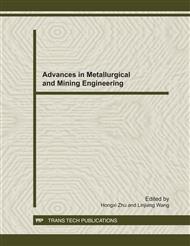p.100
p.107
p.111
p.116
p.123
p.132
p.138
p.142
p.147
Influence of Casting Speed on Solidification Process and Solidification Structure of Continuously Cast Bloom
Abstract:
On the basis of problems about quality of steel products that a certain special steel factory facing, a heat transfer model about continuous casting process was first established, then the influence of casting speed on solidification process and solidification structure of continuously cast bloom was comprehensively studied. It is shown that shell thickness leaving mold, crater length and the value of H(which is chosen as the measurement criterion of the number of the heterogeneous nucleation nucleus) are influenced most with increasing casting speed. Meantime, compared with proportional control method, solidification process of continuously cast bloom is in uniform variation with small fluctuation by target surface temperature method. What’s more, when centre solidification time is considered only, central zone macrosegregation may form more easily at last by proportional control method with increasing casting speed, but it is opposite by target surface temperature method; when the value of G/V1/2 and the value of H are considered only, the ratio of equiaxed grain will increase with increasing casting speed by proportional control method, but it is opposite by target surface temperature method.
Info:
Periodical:
Pages:
123-131
Citation:
Online since:
November 2011
Authors:
Price:
Сopyright:
© 2012 Trans Tech Publications Ltd. All Rights Reserved
Share:
Citation:


